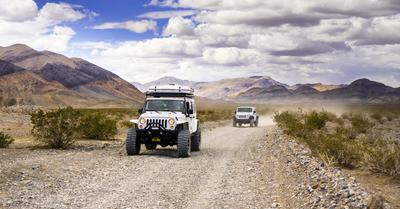One way to become more knowledgeable on a topic is by reading more. For off-road enthusiasts, we recommend doing the same by using the best books.
The best off road suspension books include:
- 4x4 Suspension Handbook
- Race Tech's Suspension Bible
- Chassis & Suspension Handbook
- Ride & Handling
- Off-Roading Log Book
- Road & Off-Road Vehicle System Dynamics Handbook
- High-Speed Off-Road Vehicles
- Race Car Vehicle Dynamics
- Competition Car Suspension
Off-road suspension can make all the difference in tackling the most challenging terrains, and staying on top of the latest developments is critical. Read ahead for a detailed look at the best books about off-road suspensions. These books have everything needed to give an edge over others.
Key Takeaways
- The three best off-road suspension books are the 4x4 Suspension Handbook, Race Tech's Suspension Bible, and Chassis & Suspension Handbook.
- Overall, adequate knowledge of how different parts work together within an off-road suspension system is vital for safe riding on challenging terrains.
- Some key concepts to become an off-road suspension expert include shocks, springs, lifts, shock absorbers, sway bars, vehicle weight, and 4WD flex.
This article may contain affiliate links where we earn a commission from qualifying purchases.
9 Best Off-Road Suspension Books
Hobbyists like outdoor enthusiasts and avid off-road riders have a knack for continually learning about their craft. We recommend using off-road suspension books to increase knowledge and find new tricks to improve vehicle performance.
Below we have listed what we consider to be the nine most influential books for off-road vehicle suspensions. They cover various topics like design, performance, and much more.
1. 4x4 Suspension Handbook
The 4x4 Suspension Handbook is an easy-to-read book written and created by Trenton McGee. He is a renowned suspension and off-road expert and enthusiast with decades of knowledge and experience.
Key topics covered in this book can turn any novice into an expert after just a few reads. Topics covered include front and rear solid axles, twin-traction beams, independent suspension systems, coil springs, leaf springs, shocks, and more.
It also provides an in-depth review of different suspension types and their differences. For example, a Toyota's standard suspension is much other than what Ford or GM produces.
This book was first published in January, 2008. It’s still relevant today and also serves as an excellent resource for older cars. It’s a fast read at only 148 pages too.
2. Race Tech's Motorcycle Suspension Bible
Another great book is Race Tech's Motorcycle Suspension Bible. It covers everything to do with off-road motorcycle design, riding, and suspensions. But it’s more in-depth, with tons of information to absorb.
Paul Thede and Lee Parks are two awesome authors with so much experience in the industry. They have created an easy-to-read book by explaining the topics for newbies to understand without much experience or knowledge.
One of the key topics we have read and reviewed numerous times is the section on suspension geometry. This is a must-read for every off-road rider looking to become more knowledgeable and informed about these topics.
Other key topics covered in this book include vehicle dynamics, chassis engineering, suspension improvement, riding, bike handling, suspension design, disassembly, and assembly. It’s more in-depth and a longer read at 256 pages, but this includes the troubleshooting guides too.
3. Chassis & Suspension Handbook
The Chassis & Suspension Handbook is slightly different. It’s a collection of the best articles compiled into one handbook focusing on early and modern systems, chassis modifications, and other basics on the topic.
We love it because it’s super easy to read. Rather than reading like a longer book, each topic gets a simple explanation in article format. This allows readers to digest information easier and finish topics faster.
One of the primary topics covered in this book is suspension and chassis modifications for major manufacturers like Chevy, Ford, Jeep, and Dodge trucks. We consider this the best resource to learn more about Jeep bump steer too.
4. Ride and Handling (Off-Road Suspension Design)
The Ride and Handling (Off-Road Suspension Design) book is much different than other books in this guide. But it’s too valuable not to include here.
It begins by explaining BAJA suspension geometry and why it matters for off-road vehicles. A dedicated section discusses and explains everything related to off-road suspension.
As we move through the book, there is more information about each part of the suspension, like the front and rear axles. It’s hard to read this book thoroughly and come away with anything less than an MBA in off-road suspensions.
There is so much detail about suspension design and how it should be built. It’s a shorter book at only 55 pages, but it’s a good choice for high-school students looking for a foundation on the topic.
5. Off Roading Log Book: Back Roads Adventure
Off-Roading Log Book: Back Roads Adventure is a great guide for adventurers and outdoorsy types. The book provides detailed maps, resources, and advice to help you plan your off-roading experience and take advantage of the beautiful back roads in any location.
From exploring remote mountain trails to peaceful country roads, this log book gives you the tools necessary for a successful trip. I especially enjoyed the sections on maintenance tips and safety precautions that keep you safe while out on your journey.
It's a must-have for anyone looking for an exciting outdoor adventure. This book has less to learn than others because it’s more useful as a resource while riding to keep track of trails ridden and other key details.
6. Road and Off-Road Vehicle System Dynamics Handbook
The Road and Off-Road Vehicle System Dynamics Handbook is an invaluable reference for anyone interested in vehicle dynamics. It covers various topics, from fundamentals to advanced applications such as suspension, steering, braking, and stability.
The authors do an excellent job of presenting complex material in easily understandable terms. The explanations are clear without oversimplifying, providing the reader with a solid foundation of knowledge about road and off-road vehicles.
The book includes numerous examples which illustrate key concepts and demonstrate practical solutions. All in all, this book is essential reading for engineers working on vehicle systems or any industry experts interested in developing more efficient, reliable, and safer vehicles.
This book covers various topics too. There is a lot of coverage on vehicle systems technologies, safety, tires, etc. Each chapter is written and reviewed by industry experts who have worked in these industries for decades.
7. High-Speed Off-Road Vehicles: Suspensions, Tracks, Wheels, and Dynamics (Automotive Series)
High-Speed Off-Road Vehicles: Suspensions, Tracks, Wheels, and Dynamics is an excellent resource for those interested in learning more about the topics of vehicle suspension systems, tracks, wheels, and dynamics.
This book provides a comprehensive overview of these concepts using clearly written explanations and easy-to-follow diagrams. The text also contains helpful safety tips when driving on rugged terrain or rough surfaces.
Everything in this book is explained to help readers become better with suspension component design and other general vehicle configurations. It offers a wealth of information so that anyone can become better informed about not just performance vehicles but also everyday transportation vehicles too.
8. Race Car Vehicle Dynamics - Problems, Answers, and Experiments
We believe Race Car Vehicle Dynamics- Problems, Answers, and Experiments is a great resource to understand the complexities of race car engineering. Engineers write it so the information is delivered in a unique way.
It’s written with detailed descriptions of vehicle components and explains aerodynamics theory in a lot of detail. The book also provides comprehensive step-by-step instructions for various problems with suspension design.
It also contains detailed graphs and diagrams, which help readers easily visualize complex concepts. Ultimately this book is an invaluable reference guide with its comprehensive coverage of everything from suspension kinematics to tire development.
It also comes with the CD-ROM to get more detailed learning when reading isn't enough. We highly recommend this book to find the most accurate information. It’s like a textbook of information rather than a traditional reading book.
9. Competition Car Suspension
Competition Car Suspension is a well-known book because of Allan Staniforth. He’s a famous author known for his expertise in this industry, and in 2006 this book was published with some incredible knowledge on the subject for readers to learn.
We recommend the fourth addition because it was upgraded with new information more relevant to modern-day vehicles. This includes vehicle dynamics, handling, and a crash course on what a suspension does and how it works.
This book primarily focuses on race car suspension systems and chassis design. It also covers various mathematics and geometry topics such as suspension and vehicle design. It’s an interesting take on a critical topic, allowing readers to gain a better understanding of the aspects of off-road racing cars.
What To Know About Off-Road Suspensions
Off-road suspensions, more importantly, a vehicle’s suspension system, are essential to consider when taking a vehicle off-roading. We can learn a decent amount from each book above on these topics too.
A vehicle’s suspension maximizes all the traction capabilities you can get out of it and maximize obstacle clearance. To ensure you have the best experience possible, here are a few things to know about off-road suspensions.
Shocks & Springs
First and foremost, sets of shocks and struts play vital roles in improving your vehicle's handling during off-roading. A vehicle can only drive successfully with reliable shocks and springs.
When choosing high-quality shocks and struts tailored to your type of riding, bear in mind they need to absorb any irregularities on rough terrain while still keeping control as best as possible.
Lifts
Lift kits add an extra level of performance by increasing clearance between obstacles by raising the height of your ride without significantly affecting its overall stability or grip capability.
This will help create better angles for greater ground clearance when driving over rocks or ledges. It can also increase ground clearance on smaller vehicles, allowing them to become off-road machines.
Dampers
Dampers on a car are suspension components that absorb shock from the car's body and help reduce or eliminate vibration during driving. The dampers connect the vehicle’s body and suspension, typically at each wheel.
They work by controlling how movement is transmitted through their components, allowing them to resist and absorb excess motion. By using dampers, many different types of vibration can be minimized or even eliminated while driving, providing a smoother ride overall.
Shock Absorbers
Shock absorbers exist to dampen the effects of bumps and vibrations on a car's suspension system. They absorb the impact from bumpy roads, potholes, and other obstacles that can be encountered while driving - allowing for a smoother ride.
They also provide stability by controlling the spring action of a car's suspension system, which can help improve handling performance resulting in greater driver control and safety.
This component is most helpful in reducing wear and tear on your tires and various other components like springs, tie rods, bearings, etc.
Torsion Bars
Sway bars also prove beneficial during extreme terrains such as mud pits or rocky hillsides. They are designed to increase torsional stiffness while decreasing body roll while navigating these conditions.
Suspension Type
These books cover this topic well. Knowing the different suspension types is the next step to becoming well-educated in this field and fully grasping how off-road suspensions work.
Off-Road Vehicle Weight
The vehicle's weight significantly impacts how off-road suspension functions. Heavier vehicles will decrease compression travel for the suspension to operate normally.
When this decreases, there is a huge increase in bump stop contact frequency. A lousy suspension will cause a car or vehicle to bounce without control.





